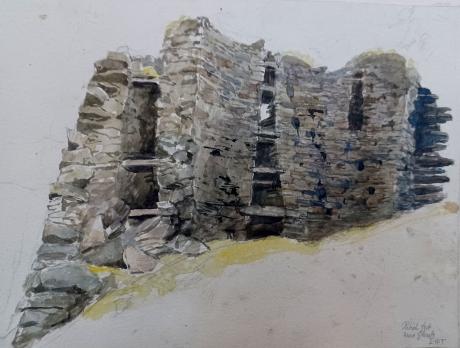inscribed and signed " Pictish Fort Nr Glengelg / LWT"
Tom and Laura Taylor and thence by descent
Dun Troddan (Scottish Gaelic: Dùn Trodan) is an iron-age broch located about 5 kilometres (3.1 mi) southeast of the village of Glenelg, Highland, in Scotland. It is one of the best-preserved brochs in Scotland.
Dun Troddan (grid reference NG83401724) stands on a level rock platform north of the Abhainn a’ Ghlinne Bhig, in the lower reaches of Gleann Beag. It lies just north of the minor road leading south from Glenelg. It can be accessed via a steep path. The neighbouring broch of Dun Telve lies 470 metres (510 yd) to the west, whilst the "semi-broch" known as Dun Grugaig is around 2 kilometres (1.2 mi) to the southeast.
Dun Troddan was first sketched in about 1720 when it was still an intact tower. It is thought that it was over 12 metres (39 ft) high in 1720, and it was described as being "by far the most entire of any in that Country". It was robbed for stone in 1722 during the construction of Bernera Barracks in Glenelg. The broch was visited by Thomas Pennant in 1772, and it was still a substantial structure, although it had lost the upper gallery by this time. It was cleared of "debris" without any supervision and consolidated by the Office of Works in the years between 1914 and 1920. The broch is now in the care of Historic Environment Scotland.
The broch consists of a drystone tower which measures around 17.5 metres (57 ft) in diameter, and currently stands to a maximum height of 7 metres (23 ft). The external walls are 4.5 metres (15 ft) thick at the base.
The entrance is on the southwest side, and is now roofless. On the left side of the entrance passage is a small side-chamber, sometimes called a "guard cell".The broch has features now missing from Dun Telve; these include a number of postholes in the floor and a hearth. Built into the hearth is a broken The central court is an almost perfect circle with a diameter of 8.56 metres (28.1 ft).
An internal doorway in the remaining high part of the wall provides access to a stairway. From here it is possible to ascend nine stairs to a first floor landing. The landing is 5.7 metres (19 ft) long, at a height of 2.4 metres (7 ft 10 in) above the central court. At the end of the landing can be seen the first step which would have led up the next flight of stairs.



Laura Wilson Barker (6 March 1819 – 22 May 1905), was a composer, performer and artist, sometimes also referred to as Laura Barker, Laura W Taylor or "Mrs Tom Taylor".
She was born in Thirkleby, North Yorkshire, third daughter of a clergyman, the Rev. Thomas Barker. She studied privately with Cipriani Potter and became an accomplished pianist and violinist. As a young girl Barker performed with both Louis Spohr and Paganini. She began composing in the mid-1830s - her Seven Romances for voice and guitar were published in 1837. From around 1843 until 1855 she taught music at York School for the Blind. During this period some of her compositions - including a symphony in manuscript, on 19 April 1845 - were performed at York Choral Society concerts.
On 19 June 1855 she married the English dramatist, critic, biographer, public servant, and editor of Punch magazine Tom Taylor. Barker contributed music to at least one of her husband's plays, an overture and entr'acte to Joan of Arc (1871), and provided harmonisations as an appendix to his translation of Ballads and Songs of Brittany (1865).
Her other works include the cantata Enone (1850), the violin sonata A Country Walk (1860), theatre music for As You Like It, (April 1880), Songs of Youth (1884), string quartets, madrigals and solo songs. Her choral setting of Keats's A Prophecy, composed in 1850, was performed for the first time 49 years later at the Hovingham Festival in 1899. The composer was present.
Several of Barker's paintings hang at Smallhythe Place in Kent, Ellen Terry's house.
Barker lived with her husband and family at 84 Lavender Sweep, Battersea. There were two children: the artist John Wycliffe Taylor (1859–1925), and Laura Lucy Arnold Taylor (1863–1940). The Sunday musical soirees at the house attracted many well-known attendees, including Lewis Carroll, Charles Dickens, Henry Irving, Charles Reade, Alfred Tennyson, Ellen Terry and William Makepeace Thackeray.
Tom Taylor died suddenly at his home in 1880 at the age of 62. After his death, his widow retired to Porch House, Coleshill in Buckinghamshire, where she died on 22 May 1905, aged 86.

